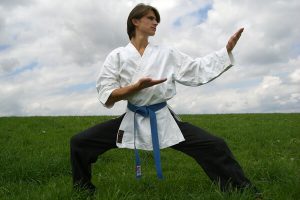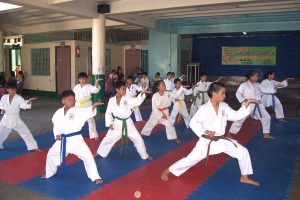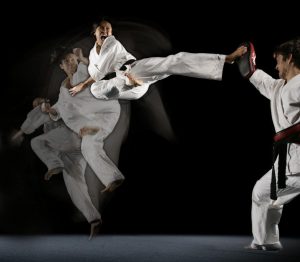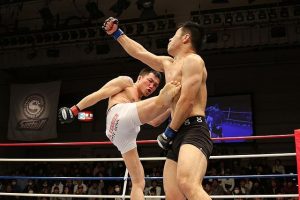Sport Rehabilitation and Physiotherapy for Martial Arts
 Participation in the martial arts has grown rapidly over the past 20 years. An increasing number of people are moving up through the ranks to maintain fitness and provide skills for self-defence. There are many benefits to participation in martial arts, such as the development of discipline, respect, strength, coordination, balance, and flexibility. These benefits, however, come with risk of injury and treatment is essential in both rehabilitation and prevention.
Participation in the martial arts has grown rapidly over the past 20 years. An increasing number of people are moving up through the ranks to maintain fitness and provide skills for self-defence. There are many benefits to participation in martial arts, such as the development of discipline, respect, strength, coordination, balance, and flexibility. These benefits, however, come with risk of injury and treatment is essential in both rehabilitation and prevention.
Martial arts injuries
 Due to the wide range of martial arts there are no “common” injuries. The injuries sustained in martial arts vary significantly with virtually all areas of the body at risk. In 2004 a study published in the British Journal of Sports Medicine looked at injuries sustained within 5 styles of martial arts (Shotokan karate, Olympic style Tae Kwon Do, Aikido, Kung Fu, and Tai Chi). They found that the type and frequency of injury varies depending on the following factors:
Due to the wide range of martial arts there are no “common” injuries. The injuries sustained in martial arts vary significantly with virtually all areas of the body at risk. In 2004 a study published in the British Journal of Sports Medicine looked at injuries sustained within 5 styles of martial arts (Shotokan karate, Olympic style Tae Kwon Do, Aikido, Kung Fu, and Tai Chi). They found that the type and frequency of injury varies depending on the following factors:
Style of martial arts
- Certain styles are more prone to injury than others (there is a threefold risk of injury in Tae Kwon Do than in Shotokan Karate for example).
- Different martial arts have different distributions of injury by body region. This is related to different techniques adopted (locks, throws, strikes etc) for each style.
- In general, across all martial arts, however, the most commonly injured areas are the lower extremities (32.3%) and upper limb (25.9), followed by trunk (17.9%) and head/ neck (17.5%).
Participation in competition
- Competitive fighting poses a larger risk of injury. Some participants may those to never compete in fighting and so reduce risk of injury.
Experience
- Participants 18 years or older with at least three years of experience are at greater risk of sustaining major injuries (35%) and multiple injuries (35%). Whereas, athletes less than 18 years with less than 3 years of experience have a low risk of multiple injuries (5%) and extremely low risk of major injuries (<1%).
Reducing the risk of martial arts related injuries
 To reduce the risk of injury in martial arts we need to apply the basic principles of “exercise preparation” and then tweak it to the demands of each martial art. This should be basically dived into “pre-exercise preparation” and “long term athletic development”.
To reduce the risk of injury in martial arts we need to apply the basic principles of “exercise preparation” and then tweak it to the demands of each martial art. This should be basically dived into “pre-exercise preparation” and “long term athletic development”.
Pre-exercise preparation
- A thorough warm up of the entire body should be performed to increase the temperature of muscle and joint and to make them more flexible and “switched on”. This can include gentle, rhythmic movements (running on the spot for example) gradually developing to more strenuous movements (squat jumps, press ups etc).
- Depending on the martial art style and focus of the lesson (i.e. arm locks, head kicks etc) the warm up should then be focused on more specific exercises to target the joints/ limbs involved. For example, this may include additional stretching of the hamstring and hip muscles in preparation for a kicking lesson.
Long term athletic development
- Based on the individual needs of each martial art, specific conditioning exercises should be developed and progressed as part of an underlying training programme (both at home and in class). The programme should look at the overall demands of the martial art and ensure that the participant is on track to meet those demands. For example, for those martial arts which involve lots grappling and arm locks the participant needs good shoulder, elbow and wrist range of movement and strength / stability throughout this range. This is an ongoing process which will need regular revision.
Treatments following martial arts related injury
 At Metro we know that due to the nature of martial arts (grappling, throws, locks and strikes) lots of traumatic injuries occur. In the “acute” (early) stage of injury there are a variety of treatment techniques which can be implemented to primarily relieve pain and reduce swelling. These include; massage, electrotherapy, acupuncture, gentle joint mobilisation and advice on ice, relative rest and exercise. Treatment is then gradually progressed to improve strength and flexibility with the overall goal of returning the participant to full levels of activity in the quickest, yet safest way possible. We also see those who haven’t had a traumatic injury but have persistent aches and pains which may affect multiple or sometimes just one technique. The staff at Metro are well trained to assess and accurately diagnose these problems with manual therapy and exercise treatment techniques which can get you back in the dojo!
At Metro we know that due to the nature of martial arts (grappling, throws, locks and strikes) lots of traumatic injuries occur. In the “acute” (early) stage of injury there are a variety of treatment techniques which can be implemented to primarily relieve pain and reduce swelling. These include; massage, electrotherapy, acupuncture, gentle joint mobilisation and advice on ice, relative rest and exercise. Treatment is then gradually progressed to improve strength and flexibility with the overall goal of returning the participant to full levels of activity in the quickest, yet safest way possible. We also see those who haven’t had a traumatic injury but have persistent aches and pains which may affect multiple or sometimes just one technique. The staff at Metro are well trained to assess and accurately diagnose these problems with manual therapy and exercise treatment techniques which can get you back in the dojo!
Martial Arts Injury Physiotherapy Specialist

All our therapists are more than capable of treating Martial Artists, however, John is our expert in this field. He acts as first contact for the team and provides in-service training to ensure they are up to date with the latest research and developments. John is a black belt (3rd Dan) in Shukokai Karate which he has practised for over 15 years and has progressed to senior instructor. John has treated many martial artists over the years including high class mixed martial arts fighters.
